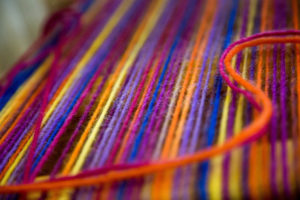You have no items in your cart. Want to get some nice things?
Go shopping
Mike Russell
I sit and sew—a useless task it seems,
My hands grown tired, my head weighed down with dreams—
The panoply of war, the martial tred of men,
Grim-faced, stern-eyed, gazing beyond the ken
Of lesser souls, whose eyes have not seen Death,
Nor learned to hold their lives but as a breath—
But—I must sit and sew.
“I Sit and Sew”
—Alice Dunbar-Nelson
Bronx, NY, 1960
Grandma’s foot sent the machine humming and whirring as she pressed down on the iron floor pedal and slid material in bits and spurts through the slotted needle. Still too young to touch the state-of the-art machine, I stood by her side, fascinated by the coordination among her fingers, the pulsating pedal and the threaded bobbin as it moved up and down, creating tiny even stitches across the pinned hem that flowed in bunches through the needle. Unable to resist, my foot tapped in time as I laid my hands lightly on the wooden surface and mimicked her motions.
Grandma noticed. Smiling widely, she motioned for me to move my hands more quickly so they wouldn’t be caught under my imaginary machine’s sharp fangs. Her goiter bobbling, she chuckled. “Laurie,” she admonished, in broken English, “Why you no put on your thimble, eh? Un dito coperto è un dito senza buchi in esso!” Unwilling to admit that I didn’t understand, I shrugged noncommittally and she shook her head knowingly. “A finger covered is a finger with no holes,” she translated. “You want your finger to bleed and soil this beautiful material? No. You want to look pretty in your Easter dress? Si. So please put on the thimble.” Grudgingly, I did so, even while I knew that it was just pretend because Gram never allowed my hands anywhere near moving parts.
Scowling, I stared at my finger where the thimble fit so snugly that it reminded me of the Chinese handcuffs my parents had purchased in Chinatown. Feeling peevish, I jammed it tighter and pretended it wouldn’t come off. When Gram ignored me, I twisted it around in circles three times, hoping for magic, but instead I heard my mother’s voice calling that it was time to do homework. Reluctant to leave, I snuggled closer to Gram.
“I tell you what, mia nipote preziosa. When you finish you homework, you come back to Grandma, eh, and I’ll tell you a secret about the thimble. Now go.” She pushed me off the stool and flicked her hand. “You no wanna keepa you mama waiting. She is not the most patient person.” Excited at the prospect of another tale about the old country, I flew down the hallway and up the stairs, prepared to practice my alphabet in record time. And I did, but then there was dinner to eat and dishes to clear; baths to take and teeth to brush. When I finally satisfied my parents, I begged to visit Grandma again to see how my dress had turned out. They acquiesced and I bolted out the door, then slid down the staircase until I landed in front of Gram’s unlocked door.
“You know where I get this thimble?” Gram began, as I climbed onto her lap. I shook my head sideways in large sweeping motions. Grandpa grunted; Grandma just ignored him and continued. “From him.” Now Grandma’s head was the one doing the swinging, as she gestured toward my grandfather who sat hunched over his demitasse cup, taciturn as ever.
“From Grandpa?” I asked, my eyes widening at the thought of this unsentimental man offering even so practical a gift as this one to his wife.
“Yes,” she sighed. “This was, how you say, common for a man to give a woman he wants to marry.” Incredulous, I asked her why and she went on to explain that thimbles were an essential part of a bride’s domestic tools. “You needa the thimble to protect not justa you finger, but the cloth you sew,” Grandma explained. “We no used to have washing machines. How you think the clothes get clean?”
I thought about this inconvenience, then stated the obvious. “By hand?”
“Si. And how harda you have to rub to wipe out blood?” she asked. I mulled over the hours of unnecessary toil that one thimble might prevent, then taking hers from her outstretched hand, I admired its tarnished surface with fresh eyes and wondered about all the young ladies in Gram’s Italian village who’d excitedly shared news about their thimble gift, in much the same way a modern woman might, her diamond ring.
But Grandma wasn’t finished. Taking the thimble back, she placed it on the table, then glanced sideways at Grandpa and gestured for him to hand her a piece of his biscotti. Nodding, he broke off a bit and gently tossed it across the Formica where Grandma covered it completely with the thimble. “You ever go to the carnivale?” she asked. When I gestured that I hadn’t, she rephrased. “You know the church bazaar?”
“You mean the one they hold in the parking lot each summer?”
“Si. The one with the goldfish and the rides.”
Confused about its connection to the thimble, I threw up my hands. “Grandma, this isn’t the old days; they don’t sell thimbles at bazaars!”
“I know,” she patiently continued, “but they play games, yes? And they hida the prize under the cuppa, no?” As recognition of the sleight-of-hand trick dawned, I slowly nodded. “See. Thisa game, it started with the thimble.” And here, she demonstrated how it would work if there were three, instead of just one sitting on the table.
“Wow. Really?” I replied. “That’s pretty cool! So the thimble began as protection but became a way to hide and cheat”?
“Si. Now you understanda.” She winked. “Now go upstairs before your mama she gets upset.”
I jumped off Gram’s lap and trudged toward the door, but not before turning to face my two co-conspirators and whispering, “Tonight, I’m going to dream about building a thimble big enough to hide under!” Grandma’s chuckle and Grandpa’s grunt followed behind me as I flew up the stairs. Once in bed, I pondered all that I’d learned and promised myself that the next time I went to our church bazaar, I’d keep my eyes on the vendor’s hands instead of the cups he moved so swiftly.
Syracuse, NY, 2018
Last night I dreamed that my grandmother was sitting at her sewing machine, stitching a hem on my new bell-bottom jeans. In the dream, Grandma’s television console sat behind her, blaring out news from the campaign trail, and I listened while watching her work, knowing that, now eighteen, I would cast my ballot for McGovern, the Democratic candidate running against Nixon in the 1972 Presidential Election. Though some pundits considered him a risky outlier because of his fierce anti-war position, I disagreed, as his platform mirrored my own idealistic views.
In the dream, though, none of this was at my mind’s forefront. I was more worried about the machine bobbin’s ability to penetrate stiff denim. Grandma noticed, too, and soon turned instead to a more arduous, but reliable, approach. Out came her most sturdy needle and her trusted thimble. Stoically, Gram grunted as she pushed the needle against the starched material until it pierced the surface, then efficiently pulled the thread through before moving on to the next stitch. All the while, I leaned against the sofa’s edge and watched her struggle until finally finished, she held the tailored hem against my petite frame.
I thanked her for her seamless stitching but she just shrugged, then gently reminded me that after immigrating to this country, she’d taken a job in a garment factory as a Pattern Maker. In this position, she was responsible for designing the prototypes that seamstresses used to create their dresses. My last thought before waking was that when it came to putting together a perfect pattern, Grandma was the best. The thimble, though, and the dream that provoked it stayed with me for days. I couldn’t shake the sense that I was missing something – a piece of the pattern, if you will.
Patterns, I ruminated. There were the war years, Grandma’s, my dad’s and my own. Grandma’s thimble was all she had left of those years because she’d mailed her wedding band back to Italy, at Mussolini’s request, so the government could melt it down into essential war capital. There was the Korean War where Dad had fought in the Battle of Pork Chop Hill, an experience that shaped his own strident opinions about the necessity of military intervention. There were my own anti-war views, shaped by the turbulent times when I came of age watching the Vietnam War unfold on television and attending funeral masses where neighbors’ bodies rested inside wooden boxes. World War II? Korea? Vietnam? Ripping apart damaged borders in the hope that stitching them into something new would bring peace, all the while attempting to protect only part of the whole from bloodshed?
Might this point to the thimble’s limited efficacy? Yet another pattern, perhaps? Curious, I began researching the word’s etymology and discovered quite a few startling facts. Did you know, for instance, that according to Hasbro, Monopoly’s most rabid players recently voted the thimble off the board? Seen as an obsolete symbol of domesticity, it’s been replaced by something more suited to the modern player. Given capitalism’s current abuses, though, I question that it’s really outlasted its relevance; so, most likely, would modern players if they were aware of its more insidious function.
As Grandma taught me long ago, thimbles have proven to be successful sleight-of-hand devices for conning naïve dreamers out of their hard earned money. What better trafficker for the famous Monopoly board than a trickster who effortlessly acquires what others must work hard to accrue, who passes “Go” with impunity because of what he’s inherited by luck of the draw?
Though seemingly trivial, might another pattern be revealing itself here? The pattern of selective memory, the result of twenty-four hour news cycles and corporate sponsorship? Might the object’s removal signify another sleight-of-hand trick, one that slips the object off the board and into oblivion, replacing it with a more trendy signifier, even while the game itself continues to emulate unhealthy cultural values? How ironic that modern gamers have deemed this seemingly innocuous symbol obsolete even while our economic, political and cultural trends mirror the values of the very era that inspired the game’s creation as a critique of economic disparity produced by sleight-of-hand measures. Such is often the distance between noble intent and perverse outcome.
Today, when inequality has reached historic proportions in a nation that supposedly values democratic principles, we’d be foolish not to ask ourselves who might be hiding coins within their palms. Foolish, too, not to pay attention to headlines that feature the phrase “Sleight of Hand” when describing events occurring prior to and since the 2016 Presidential election. Foolish not to notice news reports regarding secret tapes; cover-ups; abrupt policy reversals, and yes, even collusion with Russian oligarchs.
The thimble. It’s such a tiny, utilitarian object that does its best to provide cover for the vulnerable, just like our government is expected to do. Both are meant to protect us, but at what cost? Sometimes, cover-ups do more harm than good. Sometimes, we’re better off enduring uncomfortable pinpricks when unavoidable, while averting unnecessary bloodshed when possible. Pain, too, is a signifier, indicating that we’ve fumbled the needle and it may be time to pull out the thread and begin again.
As those who sew know, patience and discernment matter, especially when dealing with fragile fabric and costly consequences. We can abandon our efforts and leave the garment incomplete; we can force the needle where it’s unwilling or unable to go, completely bungle the process and leave the hem a tattered mess; or we can pause, then begin again, relying on past experience to guide us, knowing that it’s the very process of stitching that brings us together and makes the pattern comprehensible. In these times, as thimbles sweep across the carnival canvas that has become our country and tricksters lure us with false promises, if we wish to mend what remains salvageable, we have no choice but to sit and sew.

About Laura Iodice
Author Bio: Laura Iodice, a Bronx native, has resided with her husband in Syracuse, N.Y. for the past thirty years. She is a veteran secondary and post-secondary educator, has taught classes in literature, composition, rhetoric and cultural constructions of race and has published professionally about these subjects. Since retirement, she works as a curricular consultant and racial dialogue facilitator and as volunteer program coordinator and board member of a grassroots organization that provides mentoring and job coaching for at risk and recently incarcerated young adults. Her creative non-fiction is featured in the online journal and the print anthology of Crack the Spine, as well as in Vending Machine Press. Teaching is her vocation and writing is her life.




It is magnificent in turn and gets good knowledge and thoughts from this article. The author is giving high-quality opinion and suggestion to each reader through this article.